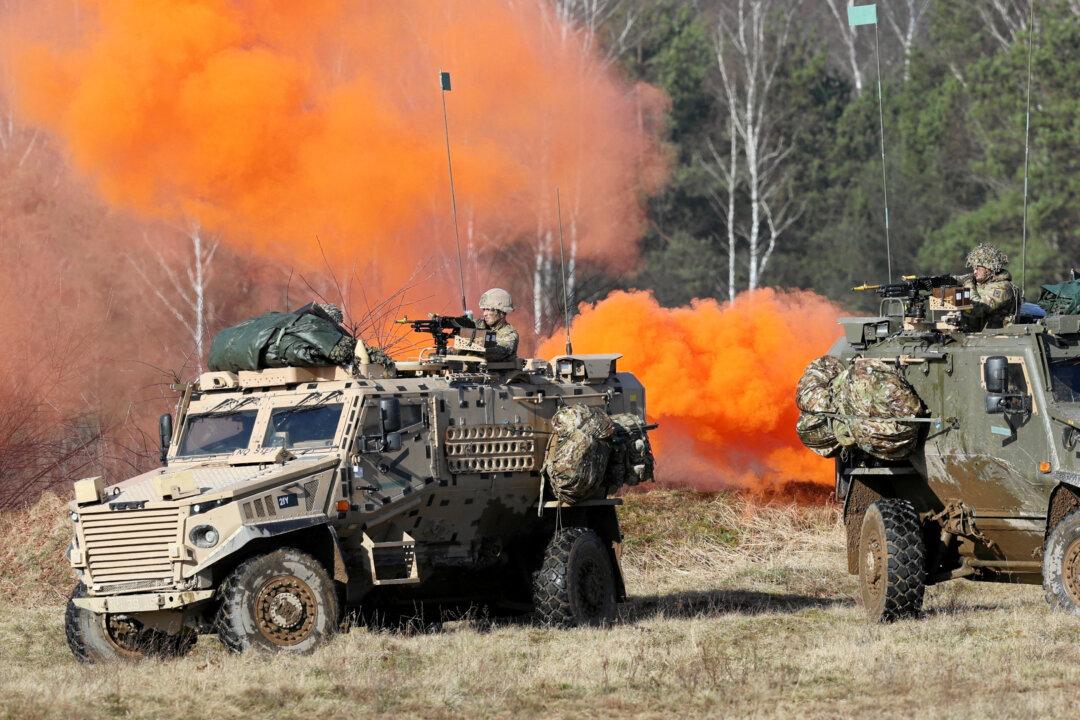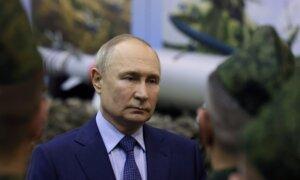Relations between Russia and the United States-led NATO alliance have deteriorated to the point of “direct confrontation,” Kremlin spokesman Dmitry Peskov has warned.
According to Mr. Peskov, NATO is “already involved in the Ukraine conflict while continuing to encroach on [Russia’s] borders and expand its military infrastructure.”
Speaking to reporters on April 4, he said that Moscow’s relations with NATO had “now deteriorated to the point of direct confrontation.”
The spokesman’s assertion coincided with the 75th anniversary of the formation of the transatlantic alliance, which was founded in Washington on April 4, 1949.
Headquartered in Brussels, NATO currently boasts 32 members following the recent accession of Finland and Sweden.
In early 2022, Russia invaded Ukraine—which is not a NATO member—with the stated aim of protecting Russian speakers in the eastern Donbas region.
Seven months later, Moscow effectively absorbed four regions of southern and eastern Ukraine, and it now considers them part of the Russian Federation.
Kyiv and its Western allies have sought to portray Russia’s invasion, which remains in full swing, as an illegitimate and unprovoked land grab.
From the outset, however, Moscow has claimed that its “special military operation” was a “natural response” to NATO’s slow but steady expansion eastward.
According to Russian officials, NATO has inched ever closer to Russia’s borders—despite earlier pledges not to do so—since the Soviet Union’s collapse in the early 1990s.
“Many times we were promised things, like the non-expansion of NATO to the east,” Russian President Vladimir Putin said in an interview last month.
“But the next thing we knew, they [NATO] were sitting on our borders,” he added.

‘Defensive Alliance’
Russia’s claims regarding NATO enlargement are not entirely without foundation.In 1999, Hungary, Poland, and the Czech Republic joined the alliance. Five years later, they were followed by Bulgaria, Estonia, Latvia, Lithuania, Romania, Slovakia, and Slovenia.
Moscow was particularly incensed by the accession of the Baltic States (Estonia, Latvia, and Lithuania), all of which share borders with Russian Federation territory.
Since then, several more European states have joined NATO, including Albania and Croatia (2009), Montenegro (2017), and North Macedonia (2020).
In 2023 and 2024 respectively, Finland and Sweden also joined the alliance, ending the two Scandinavian countries’ longstanding policy of non-alignment.
Russia described the accession of Finland—with which it shares an 830-mile-long border—as a “historic mistake” that would only increase the potential for conflict.
Last December, Sweden and Finland both signed defense pacts with the United States, allowing for the rapid deployment of U.S. troops and equipment to both countries.
At the time, Finnish Foreign Minister Elina Valtonen hailed the agreement, saying it could prove “vital in a crisis.”
Mr. Peskov warned that the potential entry of NATO “military infrastructure” into Finland would “definitely pose a threat” to Russia.
Earlier this week, Nikolai Patrushev, head of Russia’s Security Council, accused NATO of “systematically enhancing its military potential along [Russia’s] borders from the Barents Sea to the Black Sea.”
Western officials, meanwhile, reject this characterization, insisting that NATO is a purely “defensive alliance” that all democratic nations are welcome to join.
“Democratic nations, free people chose to join—unlike how Russia expands by annexation or illegal aggression,” Ms. Valtonen told reporters in Brussels on April 4.

Party to Conflict
Last summer, at a landmark NATO summit in Lithuania, Ukraine failed to obtain a formal invitation to join the Western alliance.Instead, Kyiv was assured of NATO’s support in the form of bilateral “security guarantees” with individual members, several of which have already been signed.
Nevertheless, Kyiv’s leading allies appear hopeful that Ukraine will—sooner or later—join the alliance.
“Ukraine will become a member of NATO,” U.S. Secretary of State Antony Blinken told reporters on April 4.
“Our purpose at this summit is to help build a bridge to that membership,” he said, adding that support for the move among NATO states was “rock solid.”
Mr. Blinken made the remarks at a meeting of NATO-aligned foreign ministers in Brussels, held to mark the alliance’s 75th anniversary.
Visiting foreign ministers also reportedly discussed means of stepping up NATO’s role in providing Ukraine with military assistance.
At the summit, NATO chief Jens Stoltenberg proposed a 100-billion-euro fund (roughly $108 billion) to shore up Ukraine’s military over the next five years.
“Allies understand the urgency,” Mr. Stoltenberg said after meeting with Dmytro Kuleba, Ukraine’s foreign minister.
“Allies will look into their inventories, look into if there are any ways they can provide more systems. ... but also ensure that the systems already there [in Ukraine] have the ammunition [they need].”
Gabrielius Landsbergis, Lithuania’s foreign minister, told reporters: “NATO’s biggest battles to fight are still in the future, and we have to be ready for them.”
According to Mr. Patrushev, all the recent posturing by NATO constitutes further proof that the alliance is a “de facto party” to the conflict in Ukraine.
“Collective decisions are being made [by NATO] on new arms supplies [to Ukraine] with an increase in their technical and long-range capabilities,” he said.
“NATO instructors in several countries are training mercenaries and saboteurs to participate in operations against Russia.”
Last month, Mr. Putin claimed—without providing evidence—that NATO already had boots on the ground in Ukraine.
In recent remarks to the German press, Radoslaw Sikorski, Poland’s foreign minister, said the presence of Western troops in Ukraine was an “open secret.”
The Epoch Times could not independently verify those assertions.







